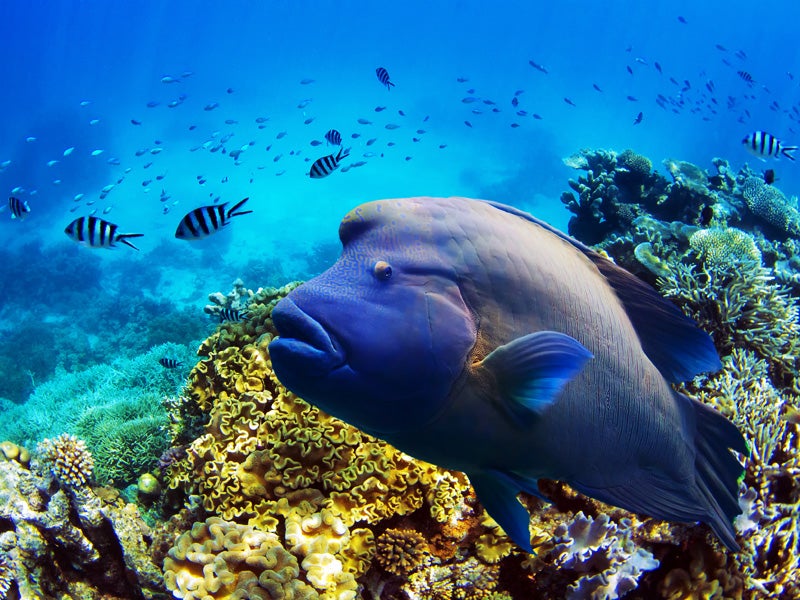Global Hunger for Coal Endangers the Great Barrier Reef
Australia’s planned expansion of coal mining and export terminals near the Great Barrier Reef threatens this iconic World Heritage site, and the World Heritage Committee must step up to protect it.

This page was published 10 years ago. Find the latest on Earthjustice’s work.
The Great Barrier Reef needs no introduction. Containing some of the most spectacular scenery in the world, the reef stretches almost 1,500 miles along the coast of northeastern Australia. It’s one of the world’s richest and most complex ecosystems, home to thousands of species of plants and animals, including turtles, whales, dolphins and the iconic dugong.
It is a unique and irreplaceable part of the earth’s natural heritage, vital to the conservation of biodiversity. The reef is on the World Heritage List, established under the international World Heritage Convention to recognize places of outstanding universal value.
But this beautiful place is in danger of being lost; more than half of the reef’s coral cover has vanished in the past 40 years. And its destruction is fueled by the world’s hunger for coal. Climate change is among the most serious threats to the reef, and it’s likely to have far-reaching consequences in the decades to come.
Ocean acidification and warming related to climate change restrict coral growth and increase the risk of mass coral bleaching, and could ultimately affect most marine life through habitat change or destruction. Climate change also amplifies the harms caused by other threats to the reef, such as water pollution and coastal development.
Not only is Australia already one of the world’s biggest exporters of coal, it is committed to massively increasing its coal production for export, including through the opening of new mega-mines in an area called the Galilee Basin. Just one of these mines will produce up to 60 million tons of coal per year for up to 60 years to be burned in power plants, accounting for 4 percent or more of the world’s total carbon emissions by mid-century (depending on the reduction in global emissions).
To add insult to injury, the coal export proposals also require harmful dredging in the Great Barrier Reef World Heritage Area to expand coal terminals on the reef’s coast, as well as more industrial shipping through the reef, which increases the risk of shipping accidents.
The survival of the reef, and indeed much of the world’s natural heritage, is imperiled by the unrelenting drive for unsustainable energy production.
The World Heritage Committee, which administers the World Heritage Convention, is currently considering whether to place the reef on the “List of World Heritage in Danger.” Such a listing would help to enhance the protection of the reef.
But when the committee released its draft decision in late May, it did not recommend the reef be listed as in danger, despite recognizing that the outlook for the reef is poor. The committee relied on Australia’s current reef protection and climate policies, which have been criticized by many scientists as inadequate. The Committee plans to finalize its decision in late June.
Earthjustice, in collaboration with lawyers from Environmental Justice Australia, has analyzed the evidence and found that the reef is clearly in danger. It meets up to six of the eight criteria established under the World Heritage Convention for listing a site as in danger—and only one of these eight must be met to allow the committee to list the reef.
One of the criteria for an in danger listing is that planned development projects threaten the reef’s integrity and inherent characteristics. Australia’s plans for new coal mines and expanded export terminals clearly meet the criteria. These expansion plans threaten an already endangered ecosystem and, on their own, are likely to justify an in danger listing.
If we are to have any chance of protecting the reef—and so many other irreplaceable parts of our world—for the health of our planet and so future generations may enjoy it as we have, we must reduce our hunger for coal. The World Heritage Committee should amend its draft decision to list the Great Barrier Reef as in danger and require Australia to significantly improve its protection of the reef.
For the World Heritage system to have any value, it must address the most serious threats to the most iconic examples of World Heritage. If any site falls into this category, it is the threatened Great Barrier Reef. The World Heritage Committee must step up to ensure this unique and vulnerable part of humanity’s global inheritance is not lost forever.
You can view a copy of the report by Earthjustice and Environmental Justice Australia on protecting the Great Barrier Reef, including our recommendations to the World Heritage Committee, here.
The International Program partners with organizations and communities around the world to establish, strengthen, and enforce national and international legal protections for the environment and public health.